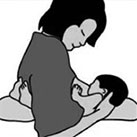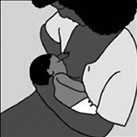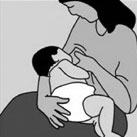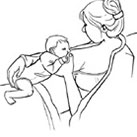Positioning You and Your Baby for Breastfeeding
The football and cross-cradle positions work particularly well in the early newborn period. With your baby in those positions, you will be able to guide baby’s head to your breast as well as support your breast. This is important in the early days since babies usually need extra support to latch on and breastfeed. They may not need as much extra support as they grow and become stronger. Other breastfeeding positions include cradle, sidelying, and laid back. These positions take a bit more practice.
General Guggestions for Positioning Baby at Your Breast:
- Sit with your back supported on a couch or chair with 1-2 pillows placed lengthwise behind you. If in bed, you may need more pillows.
- Support your baby with pillows to raise him to breast level.
- Baby should be in straight line from ear, shoulder, and hip with his entire body facing you.
- Separate baby’s arms on either side of your breasts.
Breastfeeding pillows can help with positioning:
There are many breastfeeding pillows that might be helpful with supporting your baby throughout the feeding to keep him close to your breast. You may need to use additional couch or bed pillows to raise baby to your breast level.
Football Position:

- Place 2-3 pillows alongside your body on the side you will be feeding baby.
- Place baby on pillows on his side with his head and entire body turned toward you.
- Draw baby close into your body.
- Support baby’s neck and shoulders with the hand that is on the same side as the baby.
- Support your breast with the opposite hand and hold it like a sandwich.
Cross-Cradle Position:

- Place 1-2 pillows on your lap. (You may also want pillows to support your arms.)
- Place baby on his side on the pillows with his head and entire body turned toward you.
- Draw baby close into your body.
- Support baby’s neck and shoulders with the hand that is opposite the breast being used.
- Support your breast with the hand on the same side as the breast being used.
- Hold your breast like a sandwich.
Cradle Position:

- Place 1-2 pillows on your lap.
- Place baby on his side on the pillows with his head and entire body turned toward you.
- With baby’s head resting in the crook of your arm, draw him close into your body.
- Support your breast with the opposite hand and hold your breast like a sandwich
Sidelying Position:

- Lay on your side with pillows supporting your back and head. A pillow between your knees is also helpful.
- Place baby on his side with his head and entire body turned toward you.
- You may either place baby’s head in the crook of your arm and support baby’s back with your forearm or you may lay baby on the mattress facing you and then place a rolled blanket or towel behind baby’s back for support.
- Support your breast with the opposite hand and hold your breast like a sandwich.
Laid Back Position:

- Place pillows behind you so you are reclining at a 45o angle.
- Place baby tummy down with his cheek next to your breast.
- Support your breast if necessary.
- As baby moves toward your nipple and begins to latch, gently support him.
Baby Latches Onto Your Breast
- Once you and your baby are in position to breastfeed, baby is ready to latch onto your breast.
- Guidelines for assisting baby with latching onto your breast
- Slightly tilt baby’s head back with your hand that is supporting his head.
- Baby’s chin should be up against your breast.
- Place your nipple just above baby’s upper lip.
- As baby opens his mouth widely, guide him quickly up and over the nipple with the hand supporting his head. (You may need to use your thumb to compress more breast and nipple into his mouth during this motion).
- Baby’s lower lip and jaw should draw in more areola and breast tissue than the upper lip.
- You will see baby’s chin and cheeks up against your breast. His nose will just touch your breast and he can breathe out the sides of his nose (You won’t see his lips).
How Baby Latches On
When baby feels the skin of your breast against his face and your nipple above his upper lip, his rooting reflex is stimulated. He opens his mouth widely and his tongue grasps your nipple and some of the areola (dark area surrounding nipple). He draws them back deeply into his mouth—all the way back to where his hard and soft palates meet. It is important for baby to latch onto your areola in order to effectively remove milk from the milk ducts during breastfeeding. Baby cannot easily remove milk from
your breast when he is shallowly on your nipple. For this reason, it is best to detach baby and try again for a deeper latch. It may take baby a few days to learn how to open widely and latch on, but with practice you both will become skilled.
Comfortable Latch for Mom
Breastfeeding should not hurt. You should not feel biting or pinching. It should feel like a slight pulling or tugging sensation. When the baby finishes breastfeeding the nipple should be rounded not flattened. If you see dimpling of baby’s cheeks or hear clicking sounds, then this may be signs of shallow latch. Detach your baby and try again to get a deeper latch. If soreness or damage occurs, talk with your nurse or an International Board Certified Lactation Consultant (IBCLC) for assistance.
- For breastfeeding questions and assistance after you leave the hospital, call TriHealth Breastfeeding Care Center at 513 862 7867